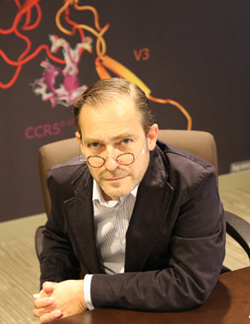Two recent breakthrough studies reported in Science Translational Medicine underscore the power of antibodies in the search for an HIV cure.
 Dr. Daniel DouekCommenting on both studies in Healthline, Dr. Rowena Johnston, amfAR’s vice president and director of research, said: “Antibodies have long been thought of as a crucial ingredient for an effective vaccine that could prevent HIV infection, but more recently, researchers are looking at enlisting antibodies to treat or possibly even cure HIV after infection has taken place.”
Dr. Daniel DouekCommenting on both studies in Healthline, Dr. Rowena Johnston, amfAR’s vice president and director of research, said: “Antibodies have long been thought of as a crucial ingredient for an effective vaccine that could prevent HIV infection, but more recently, researchers are looking at enlisting antibodies to treat or possibly even cure HIV after infection has taken place.”
In one study, a group of scientists — which included Dr. Daniel Douek, chair of amfAR’s Scientific Advisory Committee — used bispecific, or two-pronged, antibodies to access and eliminate hidden HIV reservoirs in CD4 T cells located in the lymph nodes. While vaccines and immune checkpoint inhibitors have been shown to boost CD8 T cells to kill the virus, the cells are unable to access where the reservoirs reside within the lymph nodes, Healthline reported.
 Dr. Marit van GilsHowever, researchers discovered that lymph node-derived CD8, or killer T cells, can be activated to find and kill CD4 T cells when they are cultured with a dual-functioning antibody.
Dr. Marit van GilsHowever, researchers discovered that lymph node-derived CD8, or killer T cells, can be activated to find and kill CD4 T cells when they are cultured with a dual-functioning antibody.
The approach addresses two main challenges in HIV cure research, according to Johnston — how to access and how to kill infected cells.
"They engineered an antibody that may solve both issues,” she told Healthline. “It takes the brakes off killer T cells and lets them do what they’re designed for, that is, kill virus-infected cells where they live.”
In the other study, researchers found that a combination of three antibodies can completely suppress HIV in the absence of antiretroviral therapy (ART).
 Dr. Michel C. NussenzweigInvestigators discovered three broadly neutralizing antibodies (bNAbs) — BG18, NC37, and BG1 — that bind to three different sites on the virus in a patient who was infected at least three decades ago. A small fraction of HIV-infected individuals naturally produce bNAbs and are able to control the virus.
Dr. Michel C. NussenzweigInvestigators discovered three broadly neutralizing antibodies (bNAbs) — BG18, NC37, and BG1 — that bind to three different sites on the virus in a patient who was infected at least three decades ago. A small fraction of HIV-infected individuals naturally produce bNAbs and are able to control the virus.
Scientists studied the patient’s virus five times between 2006 and 2015 and found that a single bNAb was associated with decreased viral load and all three together completely shut down HIV.
The researchers tested the antibodies in humanized mice — mice that have been injected with human stem cells. They discovered that the virus was undetectable in two-thirds of the mice three weeks after the antibodies were administered. The results led them to believe that the three bNAbs could be used as a passive immunotherapy treatment — administering antibodies made outside of the body to HIV-infected patients.
Johnston noted in the Healthline article that the combination of antibodies may prevent a treatment-resistant virus from emerging. But more studies are needed.
“It would be very interesting to know whether the antibodies … can not only neutralize the virus, but also kill the cells that produce it,” she said.
amfAR grantee Dr. Michel C. Nussenzweig of the Rockefeller University and Krim Fellow Dr. Marit van Gils of the University of Amsterdam were coauthors of the study.